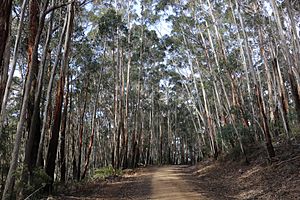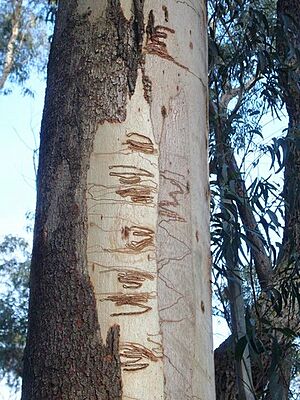White mountain ash facts for kids
Quick facts for kids White mountain ash |
|
|---|---|
 |
|
| Eucalyptus fraxinoides on Brown Mountain | |
| Scientific classification | |
| Genus: |
Eucalyptus
|
| Species: |
fraxinoides
|
| Synonyms | |
|
|
The White mountain ash, also called white ash, is a medium to tall tree. You can find it growing in the mountains of southeastern Australia. This tree is endemic to this area, meaning it naturally grows only there.
It has rough, greyish bark on the bottom part of its trunk. Higher up, the bark is smooth and white, often with interesting insect "scribbles." Its adult leaves are shaped like a spear. The tree produces white flowers from buds that grow in groups of seven to eleven. After flowering, it forms barrel-shaped or urn-shaped fruits.
Contents
About the White Mountain Ash Tree
The White mountain ash, known scientifically as Eucalyptus fraxinoides, is a tree that can grow very tall. It often reaches heights of up to 40 m (130 ft), which is about as tall as a 13-story building! This tree also has a special woody swelling at its base called a lignotuber. This helps the tree regrow if it gets damaged, for example, by a bushfire.
Bark and Leaves
The lower part of the tree's trunk has rough, greyish bark that feels a bit fibrous. Higher up, the bark changes. It becomes smooth and can be white, grey, or yellow. You might even see wiggly lines on this smooth bark, which are made by insects.
Young White mountain ash trees and new shoots have different leaves. These leaves are attached directly to the stem (they are sessile). They can be oval, egg-shaped, or spear-shaped, and measure between 60–150 mm (2.4–5.9 in) long and 15–45 mm (0.59–1.77 in) wide.
As the tree gets older, its adult leaves become lance-shaped or slightly curved. They are longer, about 80–180 mm (3.1–7.1 in) long, and 10–35 mm (0.39–1.38 in) wide. These adult leaves grow on a small stalk called a petiole, which is about 8–16 mm (0.31–0.63 in) long.
Flowers and Fruit
The flower buds of the White mountain ash grow in the axils of the leaves. They appear in groups of seven, nine, or eleven. Each group of buds is on a stalk called a peduncle, which is 5–18 mm (0.20–0.71 in) long. Each individual bud also has a tiny stalk called a pedicel, about 1–6 mm (0.039–0.236 in) long.
When the buds are ready to open, they are oval-shaped, about 5–6 mm (0.20–0.24 in) long and 3–4 mm (0.12–0.16 in) wide. They have a cap-like structure called an operculum, which can be conical or rounded.
The White mountain ash flowers during the summer months, from December to February. Its flowers are white. After the flowers, the tree produces a woody fruit. This fruit is a capsule that is shaped like a barrel or an urn. It measures about 7–11 mm (0.28–0.43 in) long and 6–11 mm (0.24–0.43 in) wide.
Discovery and Naming of White Mountain Ash
The White mountain ash was first officially described in 1898. Two scientists, Henry Deane and Joseph Maiden, wrote about it. They found specimens of the tree with William Bäuerlen on Tantawangalo Mountain, near a place called Cathcart.
Their description was published in a scientific journal called Proceedings of the Linnean Society of New South Wales. The scientific name, fraxinoides, means "likeness to Fraxinus". The suffix -oides comes from Latin and means "likeness." This name was chosen because the tree looks a bit like trees in the Fraxinus genus, which are commonly known as ash trees. For example, Fraxinus americana is also called white ash.
Where White Mountain Ash Grows
The White mountain ash thrives in cool, moist forests. You can find it on mountain ranges close to the coast and on the tablelands of southern New South Wales. It also grows in a small area of far north-eastern Victoria.
This tree often grows in groups of only its own kind, forming "pure stands." In New South Wales, it grows south from Sassafras, near Tianjara. In Victoria, it is only found in the Howe Range, which is near Mallacoota.




